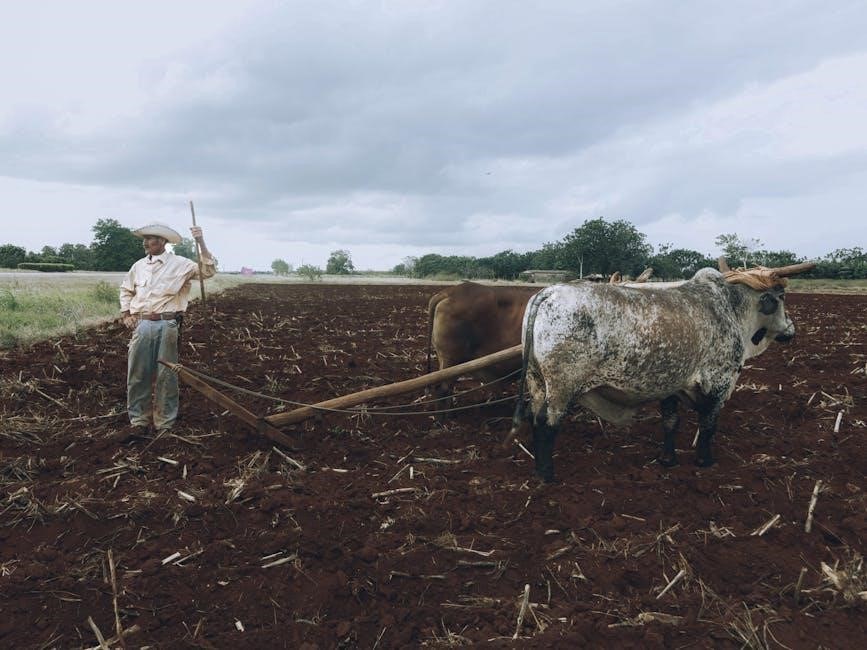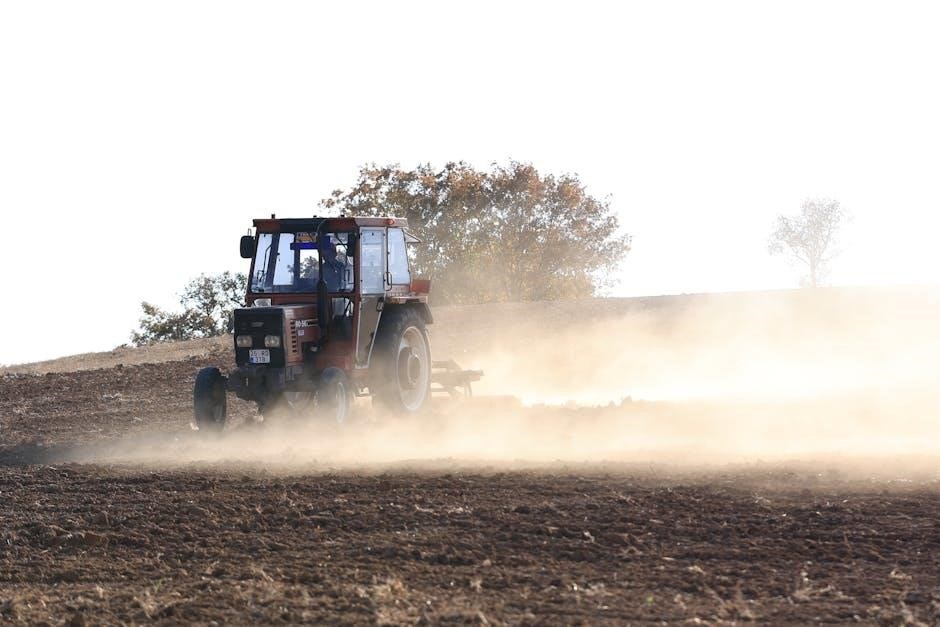A manual plow is a traditional farming tool used to till soil, vital for small-scale agriculture, sustainability, and enhancing food production while minimizing environmental impact.
Definition and Purpose
A manual plow is a simple, non-mechanized farming tool designed to till and prepare soil for planting. It typically consists of a frame, blade, and handles, allowing farmers to break and aerate soil manually. Its primary purpose is to enhance soil fertility, improve drainage, and create a suitable environment for crop growth, making it essential for small-scale and sustainable agricultural practices worldwide.
Importance in Agriculture
Manual plows play a crucial role in agriculture by enabling effective soil preparation, improving fertility, and promoting sustainable farming practices. They are particularly vital in small-scale farming, where they provide an eco-friendly and cost-effective alternative to mechanized tools. By breaking and aerating soil, manual plows enhance crop growth and yield, making them indispensable for farmers seeking traditional, environmentally conscious methods to cultivate their land efficiently.
History of Manual Plows
Manual plows trace their origins to ancient times, evolving from simple, rudimentary tools to more refined designs over centuries, reflecting human ingenuity and agricultural advancement.
Ancient Civilizations and Early Use
Manual plows were first used in ancient Mesopotamia, Egypt, and China, where early farmers employed simple, animal-drawn tools to till soil. These early plows, often made of wood, marked the beginning of agriculture. As civilizations advanced, so did plow designs, incorporating metal components for greater efficiency. This innovation enabled better crop cultivation, supporting population growth and the rise of settled communities, laying the foundation for modern farming practices.
Evolution Over Centuries
Manual plows evolved significantly over centuries, with advancements in materials and design. Iron plows replaced wooden ones, improving durability and efficiency. The addition of wheels and moldboards in medieval Europe enhanced tilling depth and soil turnover. In Asia, plows were adapted for rice cultivation. These innovations reflected regional needs, showcasing human ingenuity in agriculture and setting the stage for modern farming techniques while maintaining the plow’s essential role in sustainable practices.

Design and Construction
Manual plows feature a sturdy frame, hardwood handles, and a metal share for soil penetration. Crafted with iron or steel, they combine simplicity with durable construction for effective tilling.
Key Components
A manual plow consists of a sturdy frame, a metal share for cutting the soil, and wooden or metal handles for control. The share is typically made of iron or steel for durability. Additional components include a beam, moldboard, and sometimes a yoke for animal or human operation. These parts work together to ensure efficient soil tillage, making it a reliable tool for small-scale farming and sustainable practices.
Materials and Craftsmanship
Manual plows are crafted from durable materials like wood, metal, and steel, ensuring longevity and effectiveness. The share, typically made of iron or steel, is designed for soil penetration. Handles are often wooden for grip and control. Skilled craftsmanship ensures precision and strength, reflecting traditional techniques passed down through generations, making manual plows reliable tools for sustainable agriculture and small-scale farming.
Types of Manual Plows
Manual plows are categorized into single furrow and multiple furrow designs, each tailored for specific farming needs, ensuring efficient soil preparation and adaptability to various agricultural settings.
Single Furrow Plow
A single furrow plow is a lightweight, manually operated tool designed for small-scale farming. It tills one row of soil at a time, making it ideal for personal gardens or limited land. Its simplicity reduces environmental impact and operational costs, while its versatility allows use in various soil types and row crop cultivation, promoting sustainable and efficient farming practices for smaller agricultural needs.
Multiple Furrow Plow
A multiple furrow plow is designed for larger agricultural tasks, capable of tilling several rows simultaneously. Unlike single furrow plows, it increases efficiency and reduces the time needed for soil preparation. This tool is particularly useful for farmers managing extensive land or multiple crops, offering a practical solution for scalable farming operations while maintaining manual control and eco-friendly practices.

How to Use a Manual Plow
Using a manual plow requires proper stance, grip, and consistent effort. Maintain steady pace, align the plow correctly, and ensure smooth soil turnover for effective tilling.
Preparing the Soil
Preparing the soil is essential for effective use of a manual plow. Clear the field of debris, rocks, and weeds to ensure smooth plowing. Level the land if necessary.
Loosen the topsoil with a fork or shovel to create a manageable surface. Check for obstructions to avoid damage to the plow or injury. Proper preparation ensures efficient tilling and better crop yields.
Operating Techniques
Mastering manual plow techniques ensures efficient soil tilling. Grip the handles firmly, maintaining balance and control. Apply steady, consistent pressure to guide the plow blade through the soil. Keep the plow at the correct angle to prevent clogging or uneven tilling. Walk steadily, maintaining rhythm to cover the field uniformly. Regularly inspect the blade for debris and adjust as needed for optimal performance.
Maintenance and Repair
Regular maintenance ensures longevity and optimal performance of manual plows. Clean the blade after each use, lubricate moving parts, and store in a dry place.
Routine Maintenance
Regular maintenance is crucial for manual plows. Clean the blade after each use to prevent rust and soil buildup. Lubricate moving parts to ensure smooth operation. Store the plow in a dry, protected area to maintain its condition. Inspect and sharpen the blade periodically for optimal performance. Proper care extends the tool’s lifespan and efficiency.
Common Repairs
Common repairs for manual plows include blade sharpening or replacement due to wear or damage. Handles may crack or break, requiring substitution. Fasteners like bolts can loosen and need tightening or replacement. Regular inspection helps identify issues early, ensuring the plow remains functional. Addressing these repairs promptly prevents further damage and maintains the tool’s effectiveness for tilling and farming tasks.
Benefits of Manual Plows
Manual plows offer eco-friendly, cost-effective farming solutions, promoting sustainability without fuel use, ideal for small-scale agriculture and enhancing soil health while supporting traditional agricultural practices globally.
Environmental Impact
Manual plows significantly reduce carbon emissions by eliminating reliance on fossil fuels, promoting eco-friendly farming. They minimize soil disruption, preserving organic matter and soil health. Quiet operation reduces noise pollution, protecting wildlife habitats. By avoiding chemical inputs and machinery, manual plows support sustainable, organic farming practices, contributing to a healthier environment and food production. Their simplicity aligns with nature, fostering long-term agricultural sustainability and eco-conscious land management.
Cost-Effectiveness
Manual plows are an affordable farming tool, requiring minimal initial investment and maintenance. Their simple design reduces production costs, making them accessible to small-scale farmers. With no fuel consumption, operational expenses are significantly lower. Durable materials ensure longevity, minimizing replacement needs. This cost-efficient solution is ideal for budget-conscious agriculture, providing long-term savings and financial sustainability for farmers worldwide. Their practicality makes them a valuable asset in resource-limited settings.

Challenges with Manual Plows
Manual plows require significant physical effort, making them labor-intensive and time-consuming, especially for large-scale farming. They are best suited for small-scale agriculture, limiting their broader application.
Physical Demands
Manual plows require significant physical exertion, as they rely on human strength and endurance to till the soil. Operating one demands repetitive motion, engaging the arms, back, and legs. The repetitive lifting and pushing can lead to fatigue and strain, especially over extended periods. Proper technique is essential to minimize the risk of injury and maintain efficiency while working the land. This makes manual plows less practical for large-scale farming.
Time and Efficiency
Manual plows are labor-intensive, requiring significant time to till and prepare soil, especially for larger areas. Their slow pace compared to mechanized tools can delay planting and harvesting timelines. While effective for small plots, they are less efficient for extensive farming, making them a trade-off between environmental benefits and productivity. This challenges farmers seeking to balance sustainability with time management demands in modern agriculture.

Modern Relevance
Manual plows remain vital in small-scale farming, offering sustainable, eco-friendly solutions. They balance tradition with efficiency, supporting local food systems and reducing reliance on advanced machinery and technology.
Use in Small-Scale Farming
Manual plows are highly practical for small-scale farming, offering a sustainable and cost-effective way to till soil without heavy machinery. They are ideal for family farms or limited resources, promoting efficient land use and soil health while minimizing environmental impact. This traditional method aligns with modern sustainable practices, ensuring food production remains accessible and eco-friendly for smaller agricultural operations worldwide.

Sustainability Practices
Manual plows exemplify sustainable farming by eliminating reliance on fossil fuels and reducing carbon emissions. They promote soil conservation, prevent erosion, and preserve natural ecosystems. By maintaining soil health and biodiversity, manual plows support long-term agricultural productivity and environmental balance, making them a cornerstone of eco-friendly and responsible farming techniques that align with global sustainability goals and practices.

Safety Tips
Manual plows require proper handling to ensure safety. Always use recommended techniques and maintain equipment to prevent accidents during operation.
Preventing Accidents
To prevent accidents while using a manual plow, inspect the tool for damage before use. Wear protective clothing and ensure proper grip. Maintain focus and avoid distractions. Keep children and pets away. Follow recommended techniques to avoid overexertion or losing control. Regular maintenance ensures smooth operation and reduces mishap risks. Proper storage also prevents unintended injuries or damage.
Best Practices
Using a manual plow requires consistent effort and attention to detail. Always plow in straight, overlapping rows to ensure even soil preparation. Maintain a steady pace to avoid tiring quickly. Sharpen the blade regularly for better soil penetration. Use proper foot placement and body alignment to maximize efficiency. Store the plow in a dry, secure location after use to preserve its condition and longevity.
Manual plows remain vital tools in sustainable agriculture, offering eco-friendly solutions and promoting self-sufficiency. Their simplicity ensures accessibility and efficiency for small-scale farming, preserving traditional practices while adapting to modern needs.
Manual plows are essential tools in agriculture, historically used for tilling soil and fostering sustainable farming practices. Their simplicity and eco-friendly nature make them ideal for small-scale farming, promoting food security and reducing environmental impact. By preserving traditional methods, manual plows continue to play a significant role in modern agriculture, ensuring accessibility and efficiency for farmers worldwide.
Future Prospects
Manual plows are likely to remain relevant in sustainable agriculture, integrating modern materials and techniques to enhance efficiency. Their eco-friendly nature aligns with global efforts to reduce environmental impact, making them a viable option for small-scale farming. As technology advances, manual plows may evolve while retaining their simplicity, ensuring continued accessibility for farmers and supporting food security worldwide.
